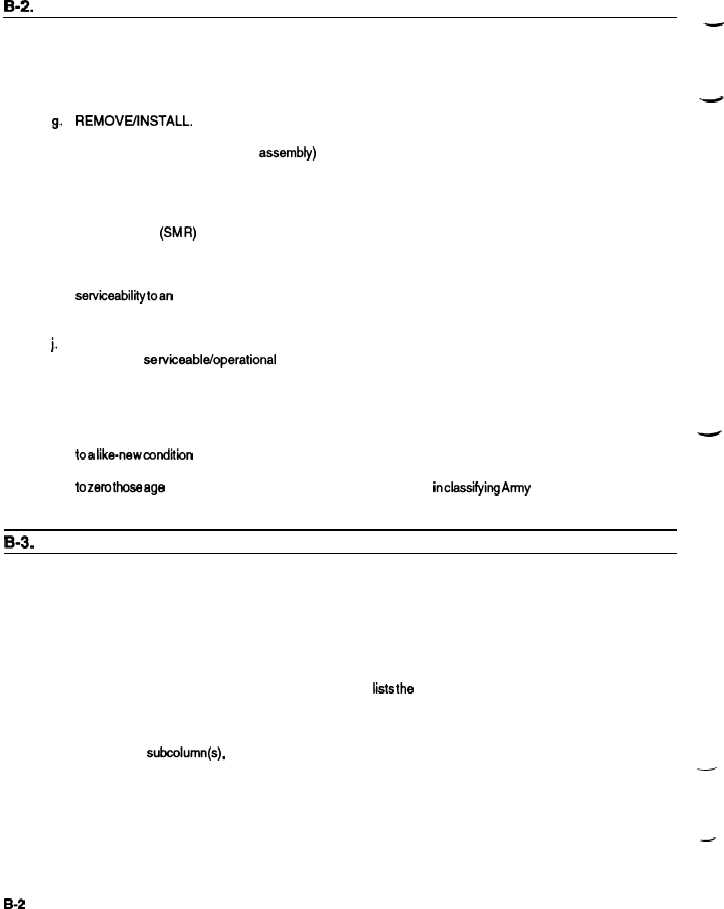|
| |
TM 9-2350-287-20-2
B-2. MAINTENANCE FUNCTIONS (continued).
f.
9.
h.
i.
j.
k.
~-
CALIBRATE. To determine the accuracy of and cause corrections or adjustments to be made on
instruments or test, measuring, and diagnostic equipment used in precision measurement. Calibration
consists of comparisons of two instruments, one of which is a certified standard of known accuracy, to
detect and adjust any discrepancy in the accuracy of the instrument being compared.
‘~
REMOVE/lNSTALL. To remove and install the same item when required to perform service or other
maintenance functions. “Install” may be the act of emplacing, seating, or fixing into position a spare, repair
part, or module (component or assembty) in a manner to allow the proper functioning of an end item or
system.
REPLACE. To remove an unserviceable item and install a serviceable counterpart in its place. “Replace”
is authorized by the MAC and is shown as the third position code of the source, maintenance, and
recoverability (SMR) code.
REPAIR. To apply maintenance services-including fault location/troubleshooting, removal/installation,
and disassembly/assembly procedures-and maintenance actions to identify troubles and restore
serviceabilitytoan item by correcting specific damage, fault, malfunction, or failure in a part, subassembly,
module (component or assembly), end item, or system.
OVERHAUL. To perform that maintenance effort (service/action) required to restore an item to a
completely senAceable/operational condition as required by maintenance standards in an appropriate
technical publication (i.e., depot maintenance work requirement). Overhaul is normally the highest
degree of maintenance performed by the Army. Overhaul does not normally return an item to like-new
condition.
REBUILD. To perform those services/actions necessary for the restoration of unserviceable equipment ~
toa Iike-newcondition in accordance with original manufacturing standards. Rebuild is the highest degree
of materiel maintenance applied to Army equipment. The rebuild operation includes the act of returning
tozemthoseage measurements (hours/miles, etc.) considered inclassifyingArmy equipment/components,
B-3. EXPLANATION OF COLUMNS IN THE MAC, SECTION II.
a.
b.
c.
d.
COLUMN 1, GROUP NUMBER. Column 1 lists functional group code numbers, the purpose of which is
to identify maintenance-significant components, assemblies, subassemblies, and modules with the next
higher assembly. The end item group number shall be “00.”
COLUMN 2, COMPONENT/ASSEMBLY. Column 2 contains the name of components, assemblies,
subassemblies, and modules for which maintenance is authorized.
COLUMN 3, MAINTENANCE FUNCTION. Column 3 Iiststhe functions to be performed on the item listed
in column 2.
COLUMN 4, MAINTENANCE LEVEL. Column 4 specifies, by the listing of a work time figure in the
appropriate subcolumn(s), the level of maintenance authorized to perform the function listed in Column
3. This figure represents the active time required to perform that maintenance function at the indicated ~
level of maintenance. If the number or complexity of the tasks within the listed maintenance function vary
at different maintenance levels, appropriate work time figures will be shown for each level. The work time
figure represents the average time required to restore an item (assembly, subassembly, component,
module, end item, or system) to a serviceable condition under typical field operating conditions. This time ~
B-2
|

